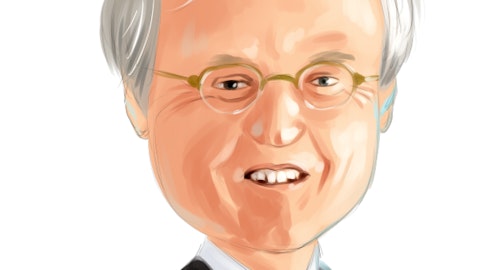Home Bancorp, Inc. (NASDAQ:HBCP) Q3 2023 Earnings Call Transcript October 19, 2023
Operator: Welcome to the Home Bancorp Incorporated Third Quarter 2023 Earnings Call. Our host for today’s call is David Kirk. At this time, all participants are in a listen-only mode. Later, we will conduct a question-and-answer session. I would now like to turn the call over to your host, Mr. Kirkley, you may begin.
David Kirkley: Thank you, Ross. Good morning, and welcome to Home Bank’s third quarter 2023 earnings call. Our earnings release and investor presentation are available on our website. I ask that everyone please refer to the disclaimer regarding forward-looking statements in the investor presentation and our SEC filings. Now I’ll hand it over to John to make a few comments about the quarter. John?
John Bordelon: Thanks, David. Good morning, and thank you for joining Home Bancorp’s earnings call today. We appreciate your interest in Home Bancorp as we discuss our results and describe our approach to creating long-term shareholder value. Home Bank has delivered exceptional results during this cycle of rapidly increasing interest rates. The third quarter was no exception as we reported above-average profitability, loan and deposit growth, and strong credit quality. It is really a testament to the strength of our relationships, many of which we’ve built over the decades, that we were able to grow deposits in the third quarter without having to rely on wholesale funding. Like everyone, we’re still seeing increases in the cost of our deposits, but most of that has been due to the remixing of our customer’s deposit balances and not because we were forced to add brokerage fees.
To put numbers behind these deposits grew by about $46 million or 7% annualized in the third quarter with most of that coming from existing customers moving funds into our CD offerings. The moving into CDs and out of savings, checking, and demand deposits brought the NIM down to 3.75% from second quarter numbers of 3.94%. Assets grew $28 million or about 3.4% annualized with loans growing $58 million or 9.3% annualized. Most of that growth was in construction development C&I and residential mortgage. Securities continued to decline and cash flows were utilized to fund loan growth. The duration of the securities portfolio is 4.5 years and is expected to generate about $50 million in principal payments over the next 15 months. With that, I’ll turn it back over to David, our Chief Financial Officer.
David Kirkley: Thanks, John. Third quarter net income was stable from the second quarter at $9.8 million, or a $1.22 per share. Deposit cost increased due to a combination of higher rates and the remixing that John referenced earlier, but the lower net interest income was offset by lower provisions, tight expense controls, and an increase in non-interest income. The increase in non-interest income was primarily due to a $640,000 gain on the sale of SBA loans, which were originated over the prior 12 months. While we expect our SBA business will generate approximately $600,000 and fee revenues per year in the current rate environment, it’s difficult to project the timing of those fees. As John mentioned, NIM declined in the third quarter, but as you can see on Slide 18, the margin declined early in July and then stabilized at around 3.75% for each month of the third quarter.

An investment banker consulting with a customer on their portfolio in a professional setting. Editorial photo for a financial news article. 8k. –ar 16:9
While there could be some additional pressure on NIM due to increasing deposit costs, we’re cautiously optimistic that the pace of decline has slowed and we are close to the bottom. Slide 19 has our historic and current deposit beta statistics and shows that our current deposit beta for our interest-bearing deposits is 31% this cycle, but average 38% in the last two rate cycles. As John mentioned, we’re pleased with our Q3 results. Return on average assets was 1.18% and return on average tangible common equity was 15.2%, which we think highlights the ability of home bank to perform well in a variety of economic environments. The 9% loan growth that John mentioned was again, above the 4% to 6% growth we were expecting this year as the loan pipeline led to stronger-than-anticipated originations.
Fortunately, deposits have kept pace and allowed us to grow profitably without having to rely on wholesale broker deposits. Based on the most recent pipeline, we expect loan growth in the fourth quarter and into next year to be a more moderate 4% to 6% growth rate. Page 13 and Page 14 of our slide deck provides some additional detail on credit, which remains very strong. We recorded a provision expense of $351,000 in the third quarter due to loan growth, which resulted in an allowance-to-loan loss ratio of 1.21%. Criticized loans have increased about 50% on an absolute basis over the past 12 months, but are still relatively low at 1.56% of total loans. The increase in substandard loans in the third quarter is primarily due to two loans, totaling $6.4 million, and we do not expect either loan to result in any losses.
It’s also worth noting that 60% of our substandard loans are paying as scheduled. Non-interest expenses increased $379,000 from the last quarter, and we expect non-interest expense to be between $21.5 million and $22 million in the fourth and first quarters. Slide 21 summarizes our capital management strategies and the impact they’ve had on home bank. Since 2018, we’ve had 8.4% growth in adjusted tangible book value per share, which includes the impact of a cash acquisition last year. During that same time, we’ve increased our dividend from $0.15 per share to $0.25 per share on a quarterly basis, and generally try to target a dividend payout ratio of 20%. We’ve repurchased about 13% of our shares outstanding since 2017 and just approved the new 5% share repurchase plan all while maintaining a consolidated CET1 capital ratio of 11.1%.
We’d like to think that these actions demonstrate our commitment to creating long-term shareholder value. We continue to believe our relationship-based approach to banking and conservative credit culture position us to succeed in any market, and that our results over the last couple of years demonstrate that. With that, Ross, please open the line for Q&A.
Operator: [Operator Instructions]. And our first question comes from Graham Dick from Piper Sandler. Please go ahead, Graham.
See also 10 Best Beaten Down Dividend Stocks to Buy and Top 20 Wine Brands Popular Among Young Consumers.
Q&A Session
Follow Home Bancorp Inc. (NASDAQ:HBCP)
Follow Home Bancorp Inc. (NASDAQ:HBCP)
Graham Dick: Good morning gentlemen. Just wanted to kind of start on the balance sheet. I know you said loan growth’s kind of going to return to that 4% to 6% pace that you’ve all been guiding to, but growth was impressive this quarter on both fronts. So, I’m just wondering how you are thinking about managing the balance between loans and deposits going forward, and maybe how that relates to where you’d like to see the loan-to-deposit ratio go in the near-term.
David Kirkley: Well, on a longer-term basis, we’d obviously, we like it somewhere between 90 and 95. That’s where we feel we’re most comfortable. But I think in the short-term, we’re seeing consistent. We’re seeing consistent movement back into the bank loan to deposit side, most of that coming in the form of CDs, but at least moving back in. We had lost earlier in the year, we were down about $130 million in deposits, all deposits. And we’re closing in, I think surely by the end of the fourth quarter, we will have recovered all that $135 million. So, deposits are continuing to grow. I think on the loan front, it is going to be more and more difficult with rising rates. 10 years continues to go up, approaching 5%. So, we’re just anticipating that loan growth will continue to slow down, as more and more people decide to just hold off on new projects.
Graham Dick: So, it sounds like you think, I mean, at least over the immediate future that the recapture of some of those deposits and general growth in customer accounts could offset loan growth and maybe see the loan-to-deposit ratio move a little bit lower from here. Is that fair?
David Kirkley: We are anticipating that, and part of the reason we think that’s going to happen, we were a little bit slow in 2022 to raise our rates. We drug our feet there, and so that caused us to lose some deposits. We didn’t lose customers, we lost deposits, and now we’re seeing some of those deposits coming back in. So, a very positive movement there as our rate are very competitive in the markets that we serve.
John Bordelon: We’ve also have not purchased any investment securities this year. We anticipate our investment securities portfolio to continue to pay down which will assist in the fund loan growth in the future.
Graham Dick: That’s John’s a good segue into my next question. Just on deposit cost, maybe David could help with this as well, but you guys closed the gap a fair amount to your deposit data guidance. I think it was 36% to 40%, that you guys gave last quarter. You’re a lot closer now, but it sounds like you think the NIM is close to a bottom. Is there any update to that deposit beta guidance you think you might be able to come in slightly below that?
John Bordelon: I think we’re at 31% for interest-bearing deposit beta, and we were, we said right around 38%. So, you’re right on that range. I don’t see that stopping, but I do see it slowing, the pace slowing and getting up to that 38%. But on the flip side, you also have your loans offsetting that repricing going forward. So, we think that we’re getting close to the bottom of NIM. We’re optimistic that it has slowed down and we feel like we’re in a good spot right today.
Graham Dick: And then just the last thing from you is on that loan repricing front. Do you guys have like, I guess the duration’s two and a half years, but how many loans are maturing, say, during 2024, I guess, or repricing renewing during 2024? Do you guys have an estimate of that?
David Kirkley: That’s one. I forgot what page that is, but it’s about 10%. That’s the investment portfolio. I’ll have to get you that number later on today.
Operator: And our next question comes from Kevin Fitzsimmons from D.A. Davidson. Please go ahead, Kevin.


